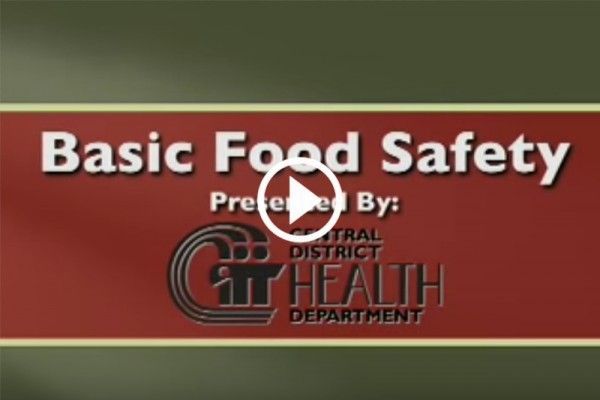This style guide provides easy edits to any recipe to improve food safety practices. Beyond creating delicious meals, people who write recipes have an important role to play in helping others remember to cook their food safely. Did you know that when recipes include food safety tips, people are more likely to follow those steps and cook their foods safely? Help prevent the spread of foodborne illness by including simple reminders for safe food handling and preparation in all your recipes.
Safe Recipe Style Guide
The Safe Recipe Style Guide, created by food safety experts and honed by leading food journalists, is designed for use by recipe writers for all published materials, including cookbooks, social media, web sites, blog entries, newspapers and magazines, and industry promotional materials.
Tips for using the Safe Recipe Style Guide in Recipes:
- When giving instructions on the amount of time food should stay in the oven, or on the stovetop, grill or other cooking device, use the guideline “Cook until internal temperature reaches XX (fill in the blank as applicable to specific food) on food thermometer.”
- Start recipes with the guideline, “Wash hands with soap and water.” Include this verbiage after each touch of raw meats, raw poultry, raw seafood, or eggs.
- When instructing recipe user to place raw meats, poultry, seafood or eggs on a surface such as a countertop, serving plate or cutting board, include the instruction to wash the surface after the touch with the raw ingredient.
- If the recipe contains a marinade that is used to baste or marinate raw or cooking meat, poultry or seafood, add the line, “Do not reuse marinades used on raw foods.”
- When describing preparation process for raw meats or poultry, include the guideline, “Do not rinse raw poultry or meat.”
- When using any form of produce in a recipe, include the following relevant guideline in the instructions with the introduction of the ingredient: “Gently rub produce under cold running water,” or “Scrub firm produce with a clean vegetable brush under running water.”
Samples of how the guideline text can be worked into a variety of types of recipes and the approved wording in the Safe Recipe Style Guide.
Write Food Safety Recipes
TEMPERATURE
Cook until internal temperature reaches XX (fill in the blank and include chart with specific foods) on food thermometer.
HAND WASHING
Wash hands with soap and water. (Include this at beginning of recipe and after each touch of raw meats, poultry, seafood or eggs).
CROSS CONTAMINATION
Wash (insert cutting board, counter, utensil, serving plate) after touching raw meats, poultry, seafood or eggs).
Do not reuse marinades used on raw foods.
Do not rinse raw poultry or meat.
PRODUCE
Gently rub produce under cold running water.
Scrub firm produce with a clean vegetable brush under running water.
While use of the wording in recipes should be as close to the above as possible, the Safe Recipe Style Guide is intended to be flexible to allow for use in recipes as needed.
Here are some tips for using the Safe Recipe Style Guide in recipes:
When giving instructions on the amount of time food should stay in the oven, or on the stovetop, grill or other cooking device, use the guideline “Cook until internal temperature reaches XX (fill in the blank as applicable to specific food) on food thermometer.”
Start recipes with the guideline, “Wash hands with soap and water.” Include this verbiage after each touch of raw meats, raw poultry, raw seafood, or eggs.
When instructing recipe user to place raw meats, poultry, seafood or eggs on a surface such as a countertop, serving plate or cutting board, include the instruction to wash the surface after the touch with the raw ingredient.
If the recipe contains a marinade that is used to baste or marinate raw or cooking meat, poultry or seafood, add the line, “Do not reuse marinades used on raw foods.”
When describing preparation process for raw meats or poultry, include the guideline, “Do not rinse raw poultry or meat.”
When using any form of produce in a recipe, include the following relevant guideline in the instructions with the introduction of the ingredient: “Gently rub produce under cold running water,” or “Scrub firm produce with a clean vegetable brush under running water.”
PREPARING FRUITS AND VEGETABLES SAFELY
All fruits and vegetables not labeled as “pre-washed” should be rinsed under running water and dried, including hard-rind produce like avocados and cantaloupes. Washing these foods helps prevent contaminants from transferring from the outside of the fruit or vegetable to the inside during peeling or cutting.
Does your recipe include produce? Add these instructions:
Cut off bruised or damaged areas.
Wash fruits and vegetables under running water, even if they will be peeled or cut. Scrub firm skins and rinds with a produce brush. Don’t use soap.
Dry with a paper towel or salad spinner.
COOKING WITH MEAT, POULTRY, SEAFOOD, EGGS, AND FLOUR
Raw meat, poultry, seafood, eggs, and flour should be stored and handled separately from produce. Remind your recipe readers and followers that it’s never safe to eat raw dough or batter (raw flour and raw eggs can contain harmful bacteria), and that a food thermometer is an important tool to ensure that meat, poultry, seafood, and eggs are cooked thoroughly and kept at a safe temperature before serving.
Add these instructions to your recipes that contain meat, poultry, seafood, eggs, or flour to make them food safe:
Wash utensils that have touched uncooked meat, poultry, seafood, eggs, or flour before using them with produce that will be eaten raw.
Clean kitchen surfaces before, during, and immediately after use when preparing food.
Wash hands often, especially after touching raw meat, poultry, seafood, eggs, or flour.
After cooking, use a food thermometer to check the temperature of the thickest part of the food to make sure that it has reached a safe minimum internal temperature:
Clean your food thermometer with soap and water before and after use.
Check that foods containing flour are baked thoroughly before tasting.
If not serving immediately, place food in a warmer that can keep it at 140 °F or above (as indicated on a food thermometer).

STORING FOOD SAFELY
Leftovers should be placed in sealed containers and refrigerated or frozen within 2 hours of preparation, or 1 hour if kept in temperatures above 90 °F. Refrigerators should be set to 40 °F or below and freezers to 0 °F or below (as indicated by an appliance thermometer) and not overfilled.

Adapt “Old Family Recipes” Safely
Some of your favorite traditional recipes may call for raw or lightly cooked eggs. These may include homemade Caesar salad dressing, ice cream, custards, rice pudding, chocolate mousse, eggnog, and some sauces.
However, some raw eggs can contain harmful bacteria. These can be particularly dangerous when consumed by those at higher risk for foodborne illness – such as pregnant women, young children, older adults, and those who may have a weakened immune system because of organ transplants or diseases like diabetes, cancer, or HIV/AIDS.
Help keep your party guests safe by adapting your favorite egg containing recipes (or substituting prepared products for some items). Here is how:
- Add the eggs to the amount of liquid called for in the recipe, then heat the mixture until it reaches 160 °F on a food thermometer.
OR
- Use store-bought products of the foods listed above, which are often already cooked or pasteurized. (Check the label to be sure.)
OR
- Purchase pasteurized eggs. These eggs can be found in some supermarkets and are labeled “pasteurized.” Here are several types consumers can buy:
- Fresh, pasteurized eggs in the shell (found in the refrigerator section).
- Liquid, pasteurized egg products (found in the refrigerator section).
- Frozen, pasteurized egg products (found in the frozen food section).
- Powdered egg whites (found in the baking section).
Recipe for Fresh Salsa
Try this recipe for fresh salsa that uses fresh garlic and fresh lime juice. Remember to refrigerate any homemade salsa until it’s time to serve. Nest the bowl in ice on the serving table or make sure you follow the two-hour rule.
Ingredients
18 fresh Roma tomatoes
1 medium jalapeño pepper, stem removed
1 small sweet onion, peeled
4 tablespoons fresh cilantro leaves
1 ½ teaspoons salt
2 tablespoons fresh garlic
2 ounces fresh lime juice
Directions
- Wash your hands, and clean the cutting board and prep area with soap and hot water.
- Rinse the tomatoes, jalapeño pepper, and cilantro under running water.
- Chop the tomatoes into small pieces.
- Finely dice the onion, jalapeño pepper, and garlic.
- Chop the cilantro leaves into small pieces.
- Combine tomatoes, peppers, onion, cilantro, salt, garlic, and lime juice in a bowl and refrigerate until serving time.
Video Playlist: Basic Food Safety Course and ServSafe Food Handler Practice Test
Food safety videos primarily targeting the food service industry. These lessons provided are suitable for the home kitchen for important food safety standards.
Information and Resources
Download Food Handling Fact Sheets
Download a quick overview for staying healthy and free from food poisoning when getting takeout, delivery or dining out. A reference guide of invaluable information on meal prep, shopping, and storage lists of DOS and DON’TS food safety from the grocery cart to the refrigerator
FoodSafety.gov Charts: Food Safety at a Glance
How long can you store leftovers in the refrigerator? How can you tell when chicken breasts are done? How long does it take to cook a turkey? Check out these charts for fast answers.
Storing Food Charts
Storing Food
Whether putting food in the refrigerator, the freezer, or the cupboard, you have plenty of opportunities to prevent foodborne illnesses.
Preparing and Cooking Food Charts
Preparing and Cooking Food
One of the basics of food safety is cooking food to its proper temperature. Foods are properly cooked when they are heated for a long enough time and at a high enough temperature to kill the harmful bacteria that cause foodborne illness.
FoodSafety.gov: FoodKeeper App
The FoodKeeper helps you understand food and beverages storage. It will help you maximize the freshness and quality of items. By doing so you will be able to keep items fresh longer than if they were not stored properly. It is also available as a mobile application for devices, Android and Apple.
Public Downloads
All items are free to view, share, and download.
Public Downloads - Español (Spanish)
When available, we provide all our content with a Spanish version in our public download section. You can find additional material from sources listed in all our articles.
Download Food Safety Activities
Download Food Safety Activity Sheets
Download Food Safety Coloring Sheets
Download Food Safety Videos
Download Food Safety Educational Infographics
Download Handwashing Activities, Worksheets, Posters and Videos
Handwashing Educational Downloads
Download Handwashing Activities
Download Scrub Club Activity Worksheets
Download Handwashing Educational Posters



















